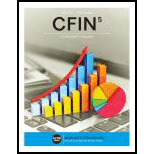
Concept explainers
Expected EPS:
Estimated income to be earned from a company to its equity shareholders. EPS stands for earnings per share.
Calculate the expected EPS as follows:
Standard deviation is used to measure the risk of the investment.
Calculate the standard deviation as follows:
Coefficient of variation:
It is ratio of standard deviation to expected return.
Calculate the coefficient of variation as follows:
EPS for two firms is given. Calculate the expected value, standard deviation and coefficient of variation for the both the firms
Want to see the full answer?
Check out a sample textbook solution
Chapter 12 Solutions
CFIN (with Online, 1 term (6 months) Printed Access Card) (New, Engaging Titles from 4LTR Press)
- Compute the (a) expected return, (b) standard deviation, and (c) coefficient of variation for investments with the following probability distributions: Probability r/A r/B 0.3 30.0% 5.0% 0.2 10.0 15.0 0.5 -2.0 25.0arrow_forwardSuppose the index model for stocks A and B is estimated with the following results: rA = 2% + 0.8RM + eA, rB = 2% + 1.2RM + eB, σM = 20%, and RM = rM − rf . The regression R2 of stocks A and B is 0.40 and 0.30, respectively. Answer the following questions. Total: (a) What is the variance of each stock? (b) What is the firm-specific risk of each stock? (c) What is the covariance between the two stocks?arrow_forwardWhat is the beta of IsoTech, given that the covariance between IsoTech and the market is 0.1 and the standard deviation of market returns is 51%?arrow_forward
- Using the single factor model for firm with a Beta of 1 and when the standard deviation of the market is .3. A) What can we say about the standard deviation of this firm’s stock? B) If a new firm Gexco has a Beta of 2 and has a standard deviation of 0.65, what is this Gexco’s firm specific risk? C) Use the known information to find the ratio of explained to total variance, also known as R-squared. Explain what R-square means using words such as systematic and firm specific risk. D) If Gexco’s expected return is 20% and the markets expected return is 12% and the risk free rate is 5%, come up with an estimate of Alpha. Explain and show how a tracking portfolio could be used and what would result. Is the possible gain risk free? 2).Write out the CAPM Model and explain each part.arrow_forwardThe market and Stock J have the following probability distributions: Probability rM rJ 0.3 15% 20% 0.4 9 5 0.3 18 12 Calculate the expected rates of return for the market and Stock J. Calculate the standard deviations for the market and Stock J. Calculate the coefficients of variation for the market and Stock J.arrow_forwardThe market has three risky assets. The variance-covariance matrix of the risky assets are as follows: r1 r2 r3 r1 0.25 0 -0.2 r2 0 4 0.1 r3 -0.2 0.1 1 Assume the market portfolio is M = 0.2 ◦ r1 + 0.5 ◦ r2 + 0.3 ◦ r3. Further assume E(rM) = 0.08. (1) What is the variance of M?(2) What is the covariance of r2 and M?(3) What is β2?(4) If the rate of return of the risk-free asset is 0.02. Then what is the fair expected rate of return of security 2?(5) An investor wants to invest in a portfolio P = 0.4◦r1+0.6◦r3. What is its “fair” expected rate of return?arrow_forward
- The expected annual returns are 15% for investment 1 and 12% for investment 2. The standard deviation of the first investment’s return is 10%; the second investment’s return has a standard deviation of 5%. A.) Which investment is less risky based solely on standard deviation? (Investment 1 or Investment 2)B.) Which investment is less risky based on coefficient of variation? (Investment 1 or Investment 2)C.) Which is a better measure given that the expected returns of the two investments are not the same? (Coefficient of Variation or Standard Deviation)arrow_forwardSuppose that the returns on an investment are normally distributed with an expected return of 16% and standard deviation of 3%. What is the likelihood of receiving a return that is equal to or less than 19%? (Hint: the area under a curve for 1 std dev is 34.13%, 2 std dev is 47.73% and 3 std dev is 49.87%.).arrow_forwarda. The standard deviation of returns is 0.30 for Stock A and 0.20 for Stock B. The covariance betweenthe returns of A and B is 0.006. The correlation of returns between A and B is:arrow_forward
- Consider an investment with the following probability distribution: Probability Payoff 0.35 38.0 % 0.40 -5.0 0.25 -17.0 Calculate the expected return. Do not round intermediate calculations. Round your answer to two decimal places. _______ % Calculate the standard deviation. Do not round intermediate calculations. Round your answer to two decimal places. _______ % Calculate the coefficient of variation. Do not round intermediate calculations. Round your answer to two decimal places. _______arrow_forwardA firm is considering an investment that has an expected return of 25% and a standard deviation of 43%. What is the investment's coefficient of variation? Do not round your intermediate calculations. Round the final answer to 2 decimal places.arrow_forwardConsider the two (excess return) index model regression results for A and B. RA= 0.9% + 1.1RM , R-square = 0.590, and Residual Standard Deviation = 11% RB= -1.4% + 0.6RM, R-square = 0.456, and Residual Standard Deviation = 9.2% Which stock has more firm-specific risk, market risk, and greater fraction of return variability for market movement? Also, if rf were constant at 4.4% and the regression had been run using total rather than excess returns, what would have been the regression intercept for stock A (write as percentage, rounded to 2 decimal places)?arrow_forward
